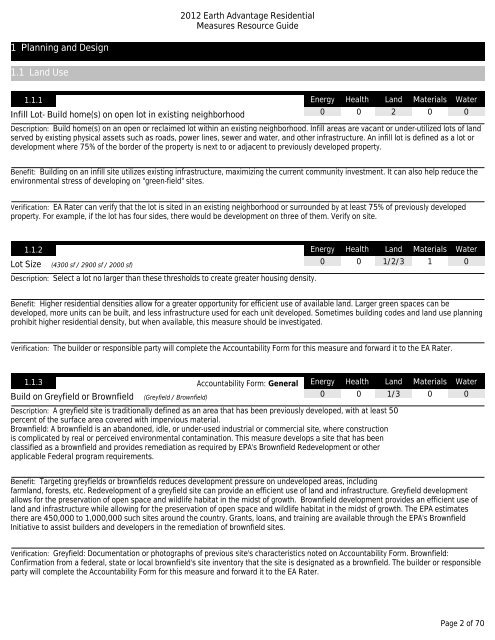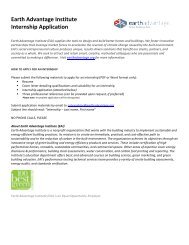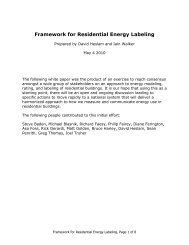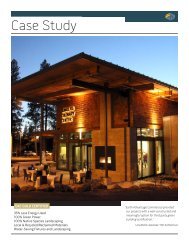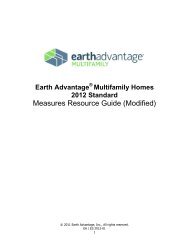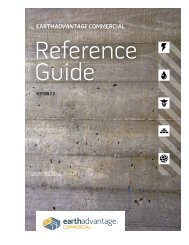EA New Homes Measures Guide - Earth Advantage
EA New Homes Measures Guide - Earth Advantage
EA New Homes Measures Guide - Earth Advantage
Create successful ePaper yourself
Turn your PDF publications into a flip-book with our unique Google optimized e-Paper software.
2012 <strong>Earth</strong> <strong>Advantage</strong> Residential<br />
<strong>Measures</strong> Resource <strong>Guide</strong><br />
1 Planning and Design<br />
1.1 Land Use<br />
1.1.1<br />
Infill Lot- Build home(s) on open lot in existing neighborhood<br />
Energy<br />
Materials<br />
Water<br />
0 0 2 0 0<br />
Description: Build home(s) on an open or reclaimed lot within an existing neighborhood. Infill areas are vacant or under-utilized lots of land<br />
served by existing physical assets such as roads, power lines, sewer and water, and other infrastructure. An infill lot is defined as a lot or<br />
development where 75% of the border of the property is next to or adjacent to previously developed property.<br />
Health<br />
Land<br />
Benefit: Building on an infill site utilizes existing infrastructure, maximizing the current community investment. It can also help reduce the<br />
environmental stress of developing on "green-field" sites.<br />
Verification: <strong>EA</strong> Rater can verify that the lot is sited in an existing neighborhood or surrounded by at least 75% of previously developed<br />
property. For example, if the lot has four sides, there would be development on three of them. Verify on site.<br />
1.1.2<br />
Energy Health Land Materials Water<br />
Lot Size (4300 sf / 2900 sf / 2000 sf)<br />
0 0 1/2/3 1 0<br />
Description: Select a lot no larger than these thresholds to create greater housing density.<br />
Benefit: Higher residential densities allow for a greater opportunity for efficient use of available land. Larger green spaces can be<br />
developed, more units can be built, and less infrastructure used for each unit developed. Sometimes building codes and land use planning<br />
prohibit higher residential density, but when available, this measure should be investigated.<br />
Verification: The builder or responsible party will complete the Accountability Form for this measure and forward it to the <strong>EA</strong> Rater.<br />
1.1.3<br />
Build on Greyfield or Brownfield<br />
(Greyfield / Brownfield)<br />
Accountability Form: General<br />
Energy<br />
Health<br />
Materials<br />
Water<br />
0 0 1/3 0 0<br />
Description: A greyfield site is traditionally defined as an area that has been previously developed, with at least 50<br />
percent of the surface area covered with impervious material.<br />
Brownfield: A brownfield is an abandoned, idle, or under-used industrial or commercial site, where construction<br />
is complicated by real or perceived environmental contamination. This measure develops a site that has been<br />
classified as a brownfield and provides remediation as required by EPA's Brownfield Redevelopment or other<br />
applicable Federal program requirements.<br />
Land<br />
Benefit: Targeting greyfields or brownfields reduces development pressure on undeveloped areas, including<br />
farmland, forests, etc. Redevelopment of a greyfield site can provide an efficient use of land and infrastructure. Greyfield development<br />
allows for the preservation of open space and wildlife habitat in the midst of growth. Brownfield development provides an efficient use of<br />
land and infrastructure while allowing for the preservation of open space and wildlife habitat in the midst of growth. The EPA estimates<br />
there are 450,000 to 1,000,000 such sites around the country. Grants, loans, and training are available through the EPA's Brownfield<br />
Initiative to assist builders and developers in the remediation of brownfield sites.<br />
Verification: Greyfield: Documentation or photographs of previous site's characteristics noted on Accountability Form. Brownfield:<br />
Confirmation from a federal, state or local brownfield's site inventory that the site is designated as a brownfield. The builder or responsible<br />
party will complete the Accountability Form for this measure and forward it to the <strong>EA</strong> Rater.<br />
Page 2 of 70


